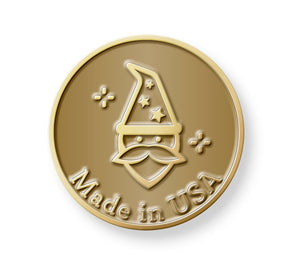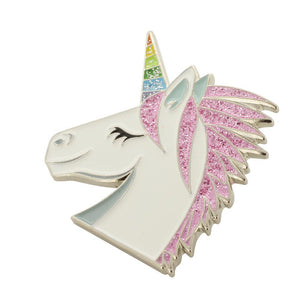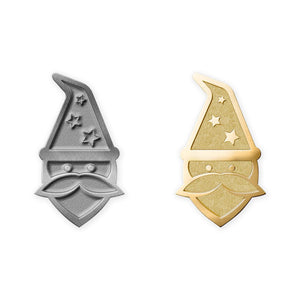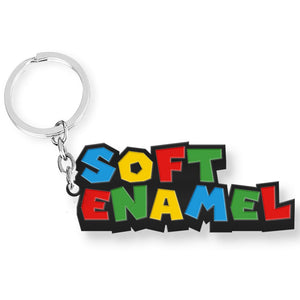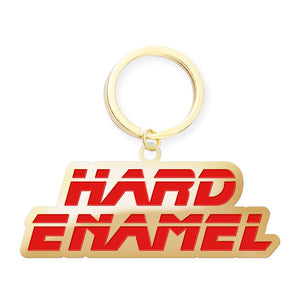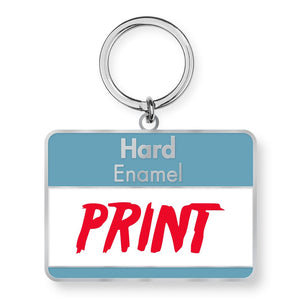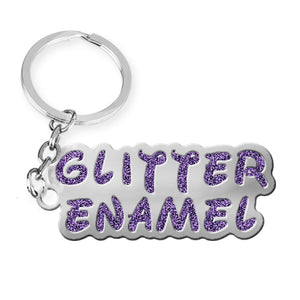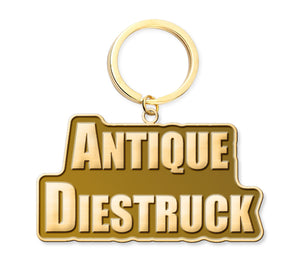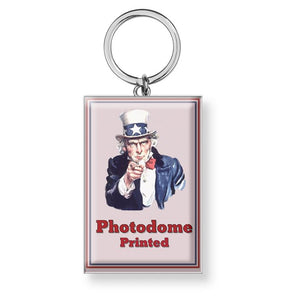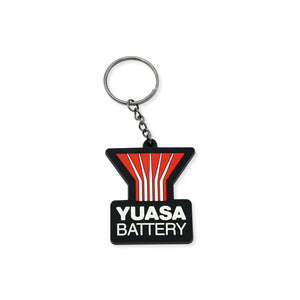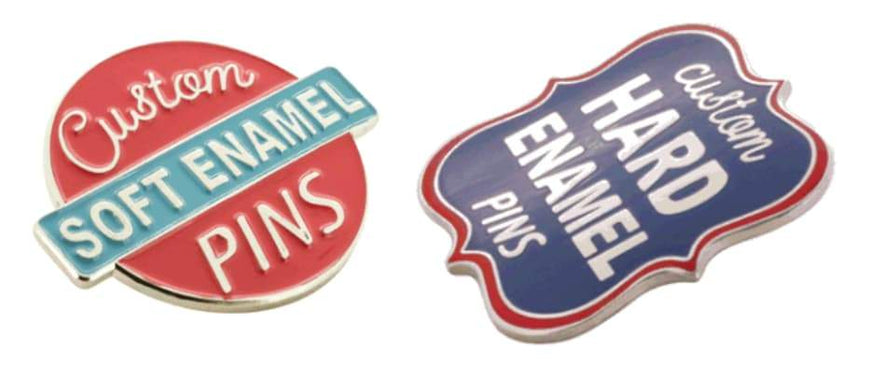Creating your first custom enamel pin is fun. But before you get into color choice, artwork, or backer design, you have an important decision to make: soft enamel or hard enamel.
What’s the difference between hard and soft enamel? Soft enamel pins have raised metal edges that give them texture, are less expensive, and offer more design flexibility. Hard enamel pins are smooth and shiny, more durable, and take longer to make.
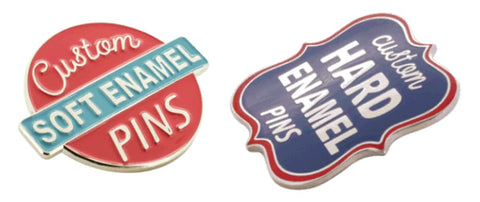
Those characteristics mean that each option is best for certain designs and pin purposes. If you’re serious about creating a pin people will love, then understanding what makes hard and soft enamel pins unique is the first step.
Soft and hard enamel pins go through different production processes
The production process for hard and soft enamel pins starts out the same: create a mold from the pin design, then use the mold to punch or form the pin’s plating (the metal base of the pin). After that, their paths to pin perfection diverge, with different steps required for each pin type.
Soft enamel pin construction
Once the plating is ready, there are three steps to completing a soft enamel pin.
1. Electroplating or dying the plating
Electroplating is the process of adding an outer layer of metal, like gold or silver, to the pin’s base of iron or zinc alloy. The plating can also be dyed with a color at this stage.
2. Enameling
The next step is to put liquefied colored enamel in the cavities of the metal base. In soft enamel pins, each cavity is only partially filled. That’s why you can feel the raised metal edges in soft enamel pins.
In this wizardly little example, the silver plating is raised, forming both the outer edge of the pin as well as some of the design elements. The colored enamel is recessed.
3. Baking

Finally, the pin gets placed in an oven and baked to set the enamel.
Hard enamel pin construction
Both the number and order of steps it takes to make a hard enamel pin are different.
1. Enamel filling
Unlike in soft enamel pins, each cavity of a hard enamel pin is overfilled with enamel. Also, note that the enamel filling happens before electroplating in this process.
2. Baking
Hard enamel pins are baked after each color of enamel is added. So if a pin has five unique colors, it will be baked five times.
3. Polishing
The enamel that’s been overfilled and baked gets polished down, so it’s level with the plating. You can still see the metal plating; it’s just smooth so there are no raised edges.
4. Electroplating
The magic of electroplating still allows you to add a thin veneer of metal over the exposed iron or zinc edges of a hard enamel pin. But you’re restricted to only shiny metals like gold or silver.
If you look closely at this funky pin we made, you’ll see the exposed, shiny gold plating. But notice it doesn’t stick out above any of the black or colored enamel sections.

Soft enamel pins allow more design flexibility
Soft enamel pins have two design advantages since they don’t go through the polishing step in the production process.
They work well with both simple and complex designs
Polishing rounds out the metal edges of a hard enamel pin. Some complex pin artwork needs some edges to remain sharp or the design becomes blurred. Since soft enamel pins don’t go through the polishing step, every exposed metal edge stays sharp.
Here’s a soft enamel pin we made as an homage to the movie Step Brothers. You can see the detailed edges of the palm tree and helicopter. Those edges would be less clear on a hard enamel pin.

And here’s an incredible example from artist and WizardPin’s customer Freehand Profit.
Source:Freehand Profit on Instagram
Profit turns deconstructed sneakers into masks, then designs pins based on those sculptures. His art has many layers of intricate detail, so soft enamel is the perfect medium for his pins.
Tattooist Dee Hutchshifted mediums from skin to pin with this beauty he calls “Anime Bae.”
Source: Dee_hutch on Instagram
The raised plating plays a huge role in this soft enamel pin’s design, forming elements like the subtle nose and slight 3D effect of the tears.
They accept any plating color
Polishing also wreaks havoc on any colored dye added to the plating. Since soft enamel pins don’t go through the polishing step, you can add any color imaginable to their plating.
Check out the creative use of color in the plating of this ’Frisco inspired pin.
When your pin calls for shiny gold or silver enamel, like this one, you need a bold color in the plating for contrast, and only soft enamel allows it.
Speaking of contrast, have a look at this magical mushroom mashup from Tuschay Studios.
Those vibrant colors are separated by a definitive black outline. If this were a hard enamel pin, the artist would have had to use either gold or silver plating, which would be overpowered by the other colors.
Hard enamel pins have a higher real and perceived value
Hard enamel pins have some limitations, but they also carry a higher perception of quality than soft enamel pins. Much of that estimation is based on esthetics, but some of it is rooted in cold, hard economics.
They cost more to produce and purchase
All that extra baking and polishing means it takes a lot more time and manual labor to turn out a hard enamel pin. In a true case of “time is money,” the extra production time translates into a higher purchase price for pin designers and buyers.
The higher cost isn’t always the deciding factor. When you’re making a luxury item, like this graceful pin from creator Rose Leon, you want every aspect of it to say “high quality.”
You can just imagine light reflecting off of the sheer surface of this pin. The artist perfectly matched her artwork with the aesthetics of a hard enamel pin.
They’re a more elegant product
Like well-polished chrome, the lustrous finish and heftier feel of hard enamel pins leave an impression of superior quality. While the raised edges of a soft enamel pin add some interesting texture, you just can’t get the same sheen.
When it comes to exuding elegance, this plant pin leaves nothing to chance.
Source: cubehousejungle on Instagram
By choosing hard enamel, the artist—an interior designer—has produced a pin that tells her clients they can expect every detail to be just right. That’s great branding for her business.
They are more durable
Multiple rounds of baking make hard enamel pins super tough. Although soft enamel pins aren’t really soft, they do suffer scratches more easily than hard enamel pins. So there is some truth behind the idea that hard enamel pins are a higher-quality product.
When you’re producing a pin for a Time Lord, like Ekitai Triad Designs has here, there’s no choice but to use the longest-lasting product available.
In fact, any time you’re making a commemorative pin that needs to stand the test of time, hard enamel should be an easy choice.
You’ve got 99 designs but your pin ain’t one
Hard or soft enamel is an important consideration for your pin. Another is the artwork you choose.
If you have a theme for your pin but lack the artistic background to make it a reality, we have the solution. We’ve partnered with 99designs to give you access to hundreds of artists and graphic designers, all competing for the chance to work with you. So you may have 99 problems, but now pin design ain’t one.
FAQs
What is a soft enamel lapel pin?
Soft enamel pins have raised metal edges that give them texture, are less expensive, and offer more design flexibility.
What's the difference between hard and soft enamel pins?
Soft enamel pins have raised metal edges that give them texture, are less expensive, and offer more design flexibility. Hard enamel pins are smooth and shiny, more durable, and take longer to make.
Why are enamel pins so expensive?
Enamel pins are manufactured by hand, one at a time. It takes hours to create each pin.
Is it expensive to make pins?
Yes, it can be expensive to make pins. The cost of the materials and the labor involved in making pins can add up quickly. But pin makers can often but pins for $2-3 and resell them for $10-$15.
Why are pins so expensive?
Enamel pins are manufactured by hand, one at a time. It takes hours to create each pin. The printing, painting, and assembling of each pin is time-consuming.
Pins usually take between 7 – 10 days to create. Each design must be confirmed 2 – 3 times before it can go into production. It's hard work collecting the proofs (mockups) and sending them back for changes. That additional communication adds days to the order cycle.






